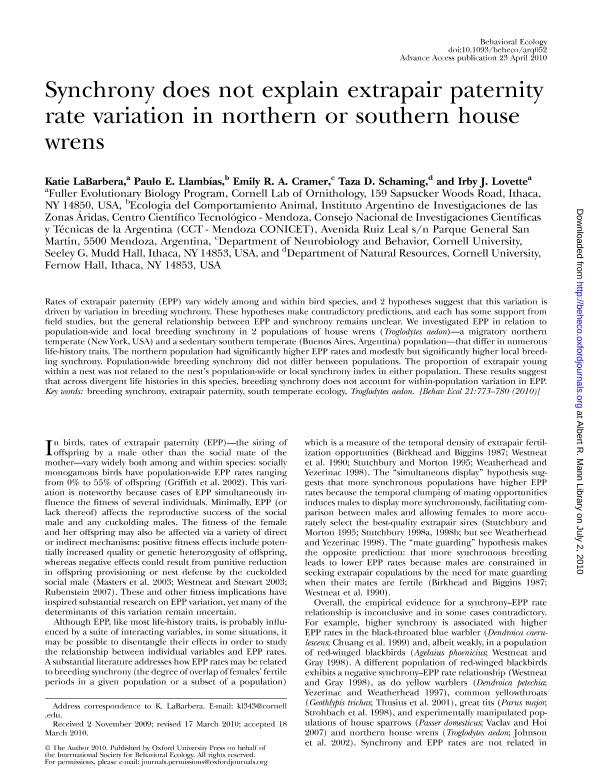Mostrar el registro sencillo del ítem
dc.contributor.author
LaBarbera, Katie
dc.contributor.author
Llambias, Paulo

dc.contributor.author
Cramer, Emily R. A.
dc.contributor.author
Schaming, Taza D.
dc.contributor.author
Lovette, Irby J.
dc.date.available
2019-05-06T15:41:42Z
dc.date.issued
2010-04
dc.identifier.citation
LaBarbera, Katie; Llambias, Paulo; Cramer, Emily R. A.; Schaming, Taza D.; Lovette, Irby J.; Synchrony does not explain extrapair paternity rate variation in northern or southern house wrens; Oxford Univ Press Inc; Behavioral Ecology; 21; 4; 4-2010; 773-780
dc.identifier.issn
1045-2249
dc.identifier.uri
http://hdl.handle.net/11336/75600
dc.description.abstract
Rates of extrapair paternity (EPP) vary widely among and within bird species, and 2 hypotheses suggest that this variation is driven by variation in breeding synchrony. These hypotheses make contradictory predictions, and each has some support from field studies, but the general relationship between EPP and synchrony remains unclear. We investigated EPP in relation to population-wide and local breeding synchrony in 2 populations of house wrens (Troglodytes aedon)-a migratory northern temperate (New York, USA) and a sedentary southern temperate (Buenos Aires, Argentina) population-that differ in numerous life-history traits. The northern population had significantly higher EPP rates and modestly but significantly higher local breeding synchrony. Population-wide breeding synchrony did not differ between populations. The proportion of extrapair young within a nest was not related to the nest's population-wide or local synchrony index in either population. These results suggest that across divergent life histories in this species, breeding synchrony does not account for within-population variation in EPP.
dc.format
application/pdf
dc.language.iso
eng
dc.publisher
Oxford Univ Press Inc

dc.rights
info:eu-repo/semantics/openAccess
dc.rights.uri
https://creativecommons.org/licenses/by-nc-sa/2.5/ar/
dc.subject
Breeding Synchrony
dc.subject
Extrapair Paternity
dc.subject
South Temperate Ecology
dc.subject
Troglodytes Aedon
dc.subject.classification
Otras Ciencias Biológicas

dc.subject.classification
Ciencias Biológicas

dc.subject.classification
CIENCIAS NATURALES Y EXACTAS

dc.title
Synchrony does not explain extrapair paternity rate variation in northern or southern house wrens
dc.type
info:eu-repo/semantics/article
dc.type
info:ar-repo/semantics/artículo
dc.type
info:eu-repo/semantics/publishedVersion
dc.date.updated
2019-04-03T15:00:21Z
dc.journal.volume
21
dc.journal.number
4
dc.journal.pagination
773-780
dc.journal.pais
Reino Unido

dc.journal.ciudad
Oxford
dc.description.fil
Fil: LaBarbera, Katie. Cornell University; Estados Unidos
dc.description.fil
Fil: Llambias, Paulo. Consejo Nacional de Investigaciones Científicas y Técnicas. Centro Científico Tecnológico Conicet - Mendoza. Instituto Argentino de Investigaciones de las Zonas Áridas. Provincia de Mendoza. Instituto Argentino de Investigaciones de las Zonas Áridas. Universidad Nacional de Cuyo. Instituto Argentino de Investigaciones de las Zonas Áridas; Argentina
dc.description.fil
Fil: Cramer, Emily R. A.. Cornell University; Estados Unidos
dc.description.fil
Fil: Schaming, Taza D.. Cornell University; Estados Unidos
dc.description.fil
Fil: Lovette, Irby J.. Cornell University; Estados Unidos
dc.journal.title
Behavioral Ecology

dc.relation.alternativeid
info:eu-repo/semantics/altIdentifier/doi/http://dx.doi.org/10.1093/beheco/arq052
dc.relation.alternativeid
info:eu-repo/semantics/altIdentifier/url/https://academic.oup.com/beheco/article/21/4/773/248716
Archivos asociados
